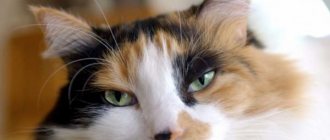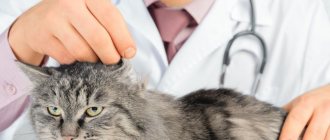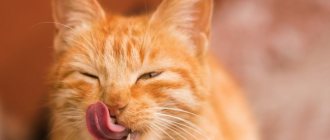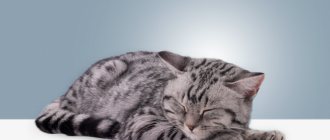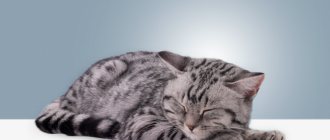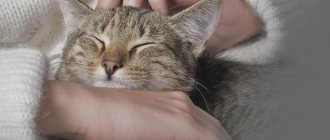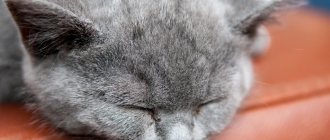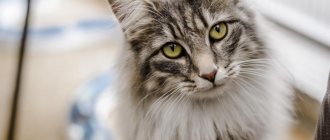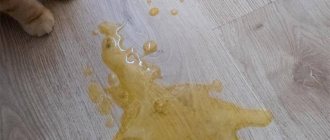The manifestation of jaundice in cats is not an independent disease. This is only a signal from the body, indicating problems in the functioning of the liver structures. In representatives of the cat family, unlike humans, jaundice rarely develops against the background of an infectious factor. That is why hepatitis in cats cannot cause human infection (except for leptospirosis).
The onset of jaundice in domestic cats is triggered by an increased accumulation of a specific protein pigment (one of the components of hemoglobin) - bilirubin. This white is part of the erythrocytes, the red blood cells that transport oxygen to all cells of the body.
Under physiologically normal conditions, red blood cells, after completing their life cycle, enter the liver and are subsequently destroyed there. Bile is produced from the products of red blood cell processing. If the liver malfunctions, red blood cells begin to break down extremely quickly, and problems arise with the production of bile acids.
Against this background, icterius develops - yellowing of the visible mucous membranes. Toxic substances that normally accumulate in the liver structures begin to penetrate into other tissues. Yellowness in a cat is observed in the area of the skin, the inside of the ear, the surface of the tongue, gums and sclera (the white membrane of the eyes).
Why does jaundice occur in dogs and cats?
With the breakdown of “outdated” red blood cells, up to 80% of bilirubin is formed in the bone marrow, spleen, and liver. At the same time, unbound bilirubin, together with albumin, is deposited in the liver and combines with glucuronic acid. Its further path is through the bile ducts into the gastrointestinal tract, where it is converted into urobilinogen. The yellowish-brown colored feces are his “work.”
If there is an increased level of bilirubin in the blood, veterinarians at the RosVet VC first determine the cause. Hyperbilirubinemia occurs:
- prehepatic, when jaundice develops as a consequence of increased formation of bilirubin due to hemolysis (disintegration, death) of red blood cells. The animal's liver is working at its limit and cannot remove all free bilirubin through the intestines. Causes of hemolysis: DIC syndrome, autoimmune diseases, oxidative stress, parasites, viruses (including leptospirosis, piroplasmosis);
- hepatic, characterized by impaired uptake. binding or secretion of bilirubin by the liver. It is a symptom of cirrhosis, hepatitis, cholongitis, DIC syndrome, taking hepatotoxic drugs (paracetamol, anticonvulsants or hormonal drugs);
- hepatic fasting (obstructive or mechanical), diagnosed when the outflow of bile through the ducts is impaired. Occurs with: tumors, cholangitis, biliary stenosis, pancreatitis.
An increased amount of bilirubin can provoke stagnation of bile, damage to the epithelial cells of the renal tubules, hepatocytes due to the formation of bilirubin casts.
Disease prevention
Regular vaccination is one of the measures to prevent jaundice.
To avoid contracting jaundice, you must follow some mandatory measures.
These include:
- high-quality and balanced diet;
- regular deworming;
- carrying out preventive examinations at the veterinarian;
- mandatory timely vaccination;
- compliance with nutritional standards.
If you comply with all these requirements, your cat will not have any health problems.
Factors that provoke jaundice
Improper maintenance and feeding of animals leads to obesity, and this, in turn, provokes pancreatitis in dogs or fatty hepatosis in cats. Some dog breeds are predisposed to jaundice, for example: cocker spaniels due to copper intoxication, Doberman pinschers (females) due to chronic active hepatitis.
Important! Incorrect administration of drugs can provoke the breakdown of red blood cells or other pathologies that are manifested by yellowness of the mucous membranes and skin. Therefore, veterinary specialists of the RosVet VC do not recommend that animal owners give medications “at random” without the participation of specialists.
Symptoms
Symptoms of jaundice in cats are not always pronounced. Icterus is observed in the area of mucous membranes (the tunica albuginea of the eye, mouth, vagina), as well as on the skin where there is not a large amount of hair (ears, abdomen). In addition to the yellow tint on the skin and mucous membranes, the following signs are observed in liver diseases:
- increased lethargy and apathy of the animal;
- eruption of gastric contents;
- disorder of the digestive process and stool;
- refusal of food;
- change in the color of excreted urine (it becomes a rich yellow color);
- disturbance of the breathing process (shortness of breath);
- painful sensations in the peritoneum;
- a sharp decrease in body weight;
- polydipsia (increased thirst).
Other signs may also appear, especially if jaundice goes away for a long time without appropriate treatment. Dysfunction of other internal organs against the background of hemolytic, mechanical or parenchymal jaundice leads to the appearance of severe symptoms of general malaise. The accumulation of toxic substances that are not excreted by the liver and kidneys leads to brain damage (in advanced cases).
Diagnostics in a veterinary clinic
The first thing people pay attention to is the symptoms preceding jaundice. The history may include:
- blood transfusion;
- tick bite;
- weakness and anorexia;
- drowsiness, shortness of breath;
- change in behavior, vomiting.
During a detailed examination, the veterinarian notes an enlarged liver, ascites, weight loss, discoloration of mucous membranes, enlarged lymph nodes in the periphery, and abdominal pain.
A number of similar diseases must be excluded, taking into account the symptoms accompanying jaundice. Thus, with prehepatic jaundice, there is an acute onset, weakness, pallor of the mucous membranes with slight jaundice and pulmonary complications (shortness of breath, tachypnea).
With hepatic jaundice, there is hepatomegaly, thirst, polyuria, the mucous membranes are not pale, and the animal behaves unusually.
Signs of posthepatic jaundice include: abdominal pain, jaundice, exacerbation of pancreatitis, lack of pallor of the mucous membranes, neoplasms in the abdominal cavity.
Causes
In veterinary medicine, there are several types of jaundice, depending on the mechanisms that provoke disruption of the liver structures. There are hemolytic, hepatic (parenchymal) and obstructive jaundice.
Infectious and non-infectious pathological processes can cause the development of hemolytic jaundice in domestic animals. The reasons for the development of hemolytic jaundice in cats are considered to be:
- parasitic diseases affecting the systemic bloodstream - hemobartonellosis and leptospirosis;
- intoxication of the body with hemolytic type poisons - salts of heavy metals, toxic substances from reptile and insect bites, plant, fungal and bacterial toxic substances;
- disturbances in the structure of the walls of red blood cells;
- blood transfusions for Rhesus conflict;
- viral immunodeficiency and feline leukemia.
These diseases lead to increased destruction of red blood cells, manifested by hemolysis and signs of jaundice. Hepatic jaundice in cats, called parenchymal jaundice, develops against the background of pathologies of the liver itself. The process of capturing protein pigment from the systemic bloodstream is disrupted, the level of bilirubin increases, and the visible mucous membranes and skin turn bright yellow.
The causes of parenchymal type jaundice in cats are as follows:
- inflammatory processes in the organ itself - hepatitis;
- failure of the liver structures developing against the background of disturbances in metabolic processes - hepatosis;
- liver damage by parasitic microorganisms - echinococcosis, opisthorchiasis or leptospirosis;
- malignant and benign neoplasms in the liver;
- replacement of normal cellular structures of the liver with fibrous tissue;
- intoxication of the body with substances.
It is worth noting that the use of certain medications can cause the development of parenchymal jaundice. One such drug is paracetamol, which causes serious complications in cats and can be fatal.
Some infectious diseases of a viral and bacterial nature also contribute to the development of parenchymal (true) jaundice.
Obstructive jaundice is called subhepatic jaundice and occurs in the vast majority of cases against the background of impaired excretion of bile secretions and its stagnation in the biliary tract. The main reasons for the development of obstructive jaundice are:
- stones in the gallbladder or bile ducts;
- inflammation of the gallbladder;
- inflammatory processes in the pancreas;
- tumor processes in the gallbladder or bile ducts;
- strictures and polyposis from the sphincter of Oddi area.
Treatment of jaundice in animals
Specialists of the RosVet VC advise that an animal with obvious signs of jaundice be placed in a 24-hour hospital inpatient clinic and limit activity. As a matter of course, the feeding diet is reviewed, and a nutritionist develops an individual diet that includes more carbohydrates and reduces the amount of sodium and protein.
In case of prehepatic jaundice, the cause of its appearance is first eliminated!
Prednisolone is used to suppress erythrophagocytosis in autoimmune hemolytic anemia. But at the same time, steroids increase the risk of developing infection, increase ascites, causing sodium retention in the body. If anemia is detected in an animal in critical condition, it is necessary to urgently resort to a whole blood transfusion.
Healthy gums and teeth in a dog
For hepatic and posthepatic jaundice, the underlying disease is identified and treated. Without this, fighting jaundice only at the symptomatic level is ineffective.
All prescriptions are administered only by a veterinarian - you absolutely cannot decide on your own what exactly your pet needs. The line of prescribing and taking into account the reasons that could cause jaundice is too fine; some drugs can also provoke it, and giving new drugs will only increase intoxication.
In case of liver failure, anesthetics, analgesics, barbiturates, tetracyclines, etc., that is, all drugs that have hepatotoxicity, are contraindicated.
If you notice that your dog or cat is showing signs of jaundice, that the mucous membranes and skin have turned jaundiced, don’t hesitate! Call the RosVet VC by phone: +, 24 hours a day. Make an appointment or urgently bring your pet for examination. Remember that some diseases require emergency care.
How is the disease treated?
Treatment of the disease directly depends on the cause of jaundice. During the period of treatment, the cat should be under the constant supervision of a veterinarian, preferably in a hospital. Hemolytic jaundice is often an indication for blood transfusion. After diagnosis, drug treatment is prescribed.
The following drugs can be used:
In some cases, the drug Globfel is used for treatment.
- Gemavit;
- Ceftriaxone;
- Fosprenil;
- Ranitidine;
- Immunofan.
Sometimes the antiviral drug Globfel is prescribed, which is administered intramuscularly for at least three days. To ease your pet's suffering, your veterinarian may recommend the use of painkillers and antiemetic medications. But only in the absence of liver failure. Under no circumstances should you give a sick animal erythromycin, tetracycline or paracetamol. These drugs destroy the liver.
Many owners have a question: how long does jaundice last in a cat? If treatment is prescribed correctly and started on time, the cat may feel relief within 1-2 weeks. It is difficult to predict when the disease will completely recede. This depends not only on the cause of the jaundice, but also on the general state of the cat’s immunity, its age and other factors. It is important to remember that all drug treatment should only be prescribed by a qualified specialist. You should not self-medicate, as it can be fatal.
Keratitis: manifestations, types and therapy
Cats lead an active lifestyle. If an animal goes outside for a walk, the risk of corneal injury increases. In the future, the situation is complicated by the addition of infection. Keratitis develops - inflammation of the cornea. The disease is severe. The cat's eyes hurt, itch and water. The animal becomes restless and cries often.
The following symptoms indicate the presence of keratitis in cats:
- Increased secretion of fluid from the eyes. In this way, the body gets rid of the infection.
- Fear of light. If the affected cornea is exposed to direct sunlight, the cat hides in a dark place.
- Discharge of pus. If an infection occurs, white or yellow pus oozes from both eyes.
- Lack of shine and clouding of the cornea. The surface of the visual organ takes on a gray tint.
If keratitis is not treated, the cat will soon develop conjunctivitis. Pathogenic microorganisms are actively multiplying. Extensive inflammation develops, affecting both organs of vision. Veterinarians call this pathology keratoconjunctivitis. If competent medical care is not provided in time, the pet may die.
In modern veterinary medicine, there are the following types of keratitis:
- purulent;
- non-purulent;
- deep;
- surface.
The cat must be shown to a doctor. The doctor will determine whether there is a foreign body in the eye. If present, it is removed. The damaged eye is washed with furatsilin solution. Xeroform ointment is placed into the conjunctival sac. Iodine-based preparations are effective.
If keratitis is caused by infection, then the eyes are treated with an antiseptic solution. Mercury ointment is placed behind the eyelid. To relieve inflammation and boost immunity, veterinarians advise using aloe-based medications. Warming compresses should be used carefully and only with the permission of a doctor. Otherwise, the inflammation may worsen.
Kitten eye color
Most kittens are born with blue eyes. But as their vision sharpens over the weeks after birth, their eye color changes. At about 3-8 weeks of age, it may be brownish-yellow. Sometimes shades of amber and green are noticeable.
Note that the final color, its intensity and shade are determined by melanocytes, as well as the amount of melanin secreted. Therefore, if a cat has light green eyes even as an adult, it means that he produces little melanin, and if he has brown eyes, it means the opposite.
Some cats have blue eyes for life, and this is not a pathology. This is typical for the following breeds:
- Siamese;
- Burmese;
- Javanese;
- ragdoll;
- Tonkinese;
- Balinese, etc.
Sometimes blue eye color is not caused by low melanin content, but by the presence of a gene that suppresses pigments. This is in most cases typical for white cats.
